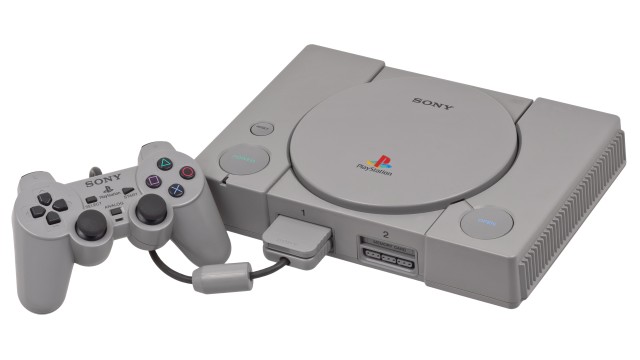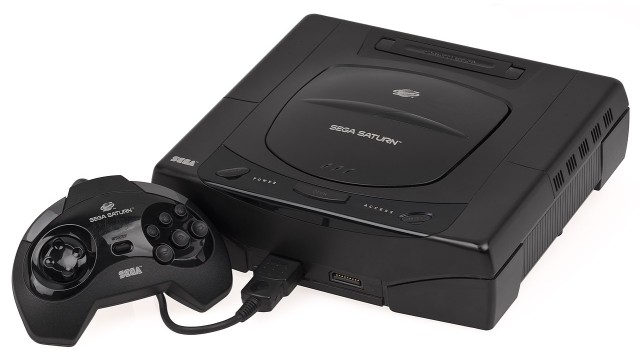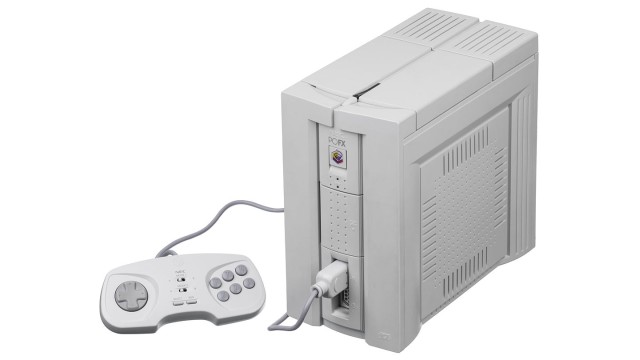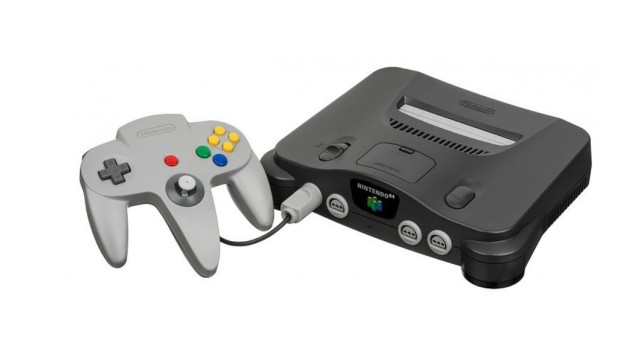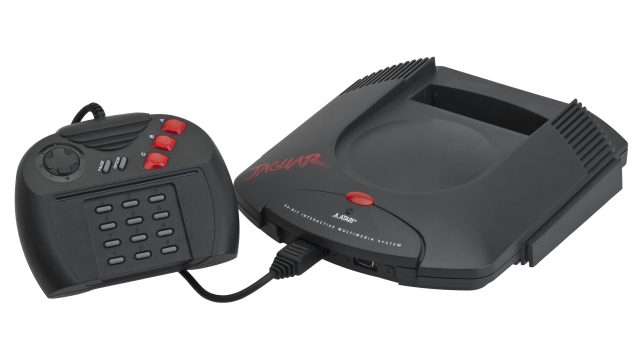
Atari Jaguar
Launches: 1993
Discontinued: 1996
Life span: 3 years
Units sold: 250 000
Generation: 5th
Country releases of Atari Jaguar
 USA: USA: | 15/Nov/1993 | 250 | $ |
 Australia: Australia: | 01/Aug/1994 | 700 | $ |
 Germany: Germany: | 01/Nov/1994 | ||
 Japan: Japan: | 08/Dec/1994 | 29800 | ¥ |
 Spain: Spain: | 01/May/1995 | 39990 | PTS |
 Atari Jaguar technical specifications
Atari Jaguar technical specifications
CPU: "Tom" X3 CPU
32-bits @ 25.59 MHz &
"Jerry" X2 CPU
32-bits @ 2 (32 bits)
Memory: 2 MB
 Atari Jaguar video specifications
Atari Jaguar video specifications
Atari Jaguar graphics capabilities.
Video chip: "Tom" @ 26.59 MHz (64 bits)
Video connection: RGB/SCART
Atari Jaguar video modes
| 800×576 | 16777216 colors using a 16777216 colors palette |
 Atari Jaguar audio specifications
Atari Jaguar audio specifications
Atari Jaguar sound capabilities.
Audio chip: "Jerry" @ 26.6 MHz
Audio mode: Stereo
 Controllers of Atari Jaguar
Controllers of Atari Jaguar
 Atari Jaguar games support
Atari Jaguar games support
Support: Cartridge
Atari Jaguar games
Games library: 50
Atari Jaguar story
The Atari Jaguar was Atari's ambitious attempt to reclaim its position as a leader in the home console market during the early 1990s, a period marked by rapidly advancing technology and intense competition. The creation, development, launch, and market reception of the Atari Jaguar encapsulate both the bold vision Atari had for the future of gaming and the significant challenges that ultimately led to its downfall.
The creation of the Atari Jaguar was born out of a desire to leapfrog the competition by offering a console that was significantly more powerful than anything else on the market. By the early 1990s, Atari was no longer the dominant force it had been in the video game industry during the early 1980s. The company had struggled with the failures of previous consoles like the Atari 5200 and the Atari 7800, and its relevance had diminished in the face of competition from Nintendo and Sega. As these companies dominated the 16-bit era with the Super Nintendo Entertainment System (SNES) and Sega Genesis, Atari sought to disrupt the market by introducing a console that would be a generation ahead in terms of technology.
To achieve this, Atari set out to develop a console that would surpass the existing 16-bit systems and offer something that the market had not yet seen: 64-bit processing power. The idea was to create a system that would be capable of delivering far superior graphics, sound, and overall gaming experiences, making it the most advanced console on the market. The project was initially codenamed “Panther” and was conceived as a 32-bit console to compete with the SNES and Genesis. However, as technology progressed, Atari shifted its focus to developing a more powerful system, leading to the cancellation of the Panther project in favor of what would become the Atari Jaguar.
The development of the Atari Jaguar was undertaken by a small team within Atari, led by engineers John Mathieson and Martin Brennan of Flare Technology, a company that Atari had acquired to help with hardware development. The Jaguar’s architecture was highly ambitious, featuring a multi-chip design that included a Motorola 68000 CPU, which was used as a general-purpose processor, and two custom chips, nicknamed “Tom” and “Jerry”, that were designed to handle the system’s graphics and audio processing. These chips were intended to work together to deliver 64-bit performance, with “Tom” focusing on graphics rendering and “Jerry” handling audio tasks and additional processing duties.
One of the key selling points of the Jaguar was its ability to handle complex 3D graphics, something that was not yet commonplace in home consoles. Atari’s engineers believed that the Jaguar’s architecture would enable developers to create games with rich, detailed environments and fluid animations that would set the system apart from its competitors. However, the Jaguar’s complex hardware architecture also presented significant challenges. The system’s multi-chip design was difficult to program for, and many developers struggled to unlock the full potential of the hardware. The decision to use the Motorola 68000 CPU, which was technically a 16/32-bit processor, alongside the custom 64-bit chips led to confusion and criticism, with some questioning whether the Jaguar was truly a 64-bit console.
Despite these challenges, Atari pressed forward with the development of the Jaguar, eager to bring it to market before the next generation of consoles from competitors like Sony and Sega. The company was determined to position the Jaguar as the most powerful gaming system available, emphasizing its 64-bit architecture as a major selling point. Atari’s marketing efforts highlighted the Jaguar’s advanced technology, with slogans like “Do the Math” aimed at convincing consumers that the Jaguar was a quantum leap beyond the 16-bit systems that dominated the market at the time.
The launch of the Atari Jaguar took place in November 1993, initially in a limited release in New York City and San Francisco, before expanding to a wider release in early 1994. Atari priced the Jaguar competitively at $249.99, which was in line with other consoles on the market, and the system came bundled with the game Cybermorph, a 3D space shooter that was designed to showcase the Jaguar’s advanced graphics capabilities. Atari’s goal was to establish the Jaguar as the leading console in the market before the release of other next-generation systems like the Sony PlayStation and Sega Saturn, both of which were still in development.
However, the Jaguar’s launch was met with mixed reactions. While the system’s graphics were generally praised, particularly in comparison to 16-bit consoles, the early lineup of games was seen as underwhelming. Cybermorph, despite its technical achievements, was criticized for its repetitive gameplay and lack of depth. Additionally, the Jaguar’s controller, which featured a large numeric keypad, was seen as bulky and unwieldy by many players. The initial batch of games for the Jaguar failed to capture the imagination of consumers, and there were concerns about the system’s long-term viability, particularly given the lack of third-party support.
One of the biggest challenges Atari faced following the Jaguar’s launch was attracting third-party developers to create games for the system. While Atari had a few strong titles in development, including Alien vs. Predator, which would go on to become one of the Jaguar’s most acclaimed games, the overall library of games was limited. Many developers were hesitant to commit to the Jaguar due to the system’s complex architecture and the uncertain future of Atari as a company. Additionally, with the upcoming launches of the PlayStation and Sega Saturn, many developers chose to focus their efforts on these systems, which promised more robust development environments and greater market potential.
The market reception of the Atari Jaguar was disappointing for Atari. Despite the initial buzz surrounding its launch, sales of the console quickly began to stagnate. By the end of 1994, it was clear that the Jaguar was struggling to gain traction in the market. The lack of a compelling game library, combined with the growing anticipation for the PlayStation and Saturn, left the Jaguar in a difficult position. Atari attempted to boost sales by lowering the price of the console and introducing new peripherals, such as the Jaguar CD add-on, which was released in 1995 and was intended to provide expanded storage capacity for more complex games. However, these efforts did little to revive the Jaguar’s fortunes.
As the PlayStation and Saturn were released in 1994 and 1995, respectively, the Jaguar’s position in the market became even more precarious. Both of these new systems offered powerful 3D graphics capabilities, extensive game libraries, and strong third-party support, making it increasingly difficult for the Jaguar to compete. Atari’s financial situation continued to deteriorate, and by 1996, the company had ceased production of the Jaguar. With fewer than 250,000 units sold, the Jaguar is widely regarded as a commercial failure.
The failure of the Atari Jaguar marked the end of Atari’s involvement in the home console market. The company, which had once been a pioneer in the industry, was unable to adapt to the changing landscape of video gaming in the 1990s. The Jaguar’s complex architecture, lack of strong third-party support, and the rapid pace of technological advancement all contributed to its downfall. In the years that followed, Atari would transition away from hardware development and focus on its remaining software and intellectual property assets.
In retrospect, the Atari Jaguar is often seen as a case of missed opportunities and unfulfilled potential. While it was undeniably ambitious, aiming to deliver cutting-edge technology and a next-generation gaming experience, the execution fell short in key areas. The console’s innovative design was undermined by its complexity, and the lack of compelling software ultimately sealed its fate. The Jaguar remains a cautionary tale in the history of video gaming, illustrating the challenges of pushing the boundaries of technology without the necessary support and infrastructure to back it up.
Previous Atari console: Atari 7800
